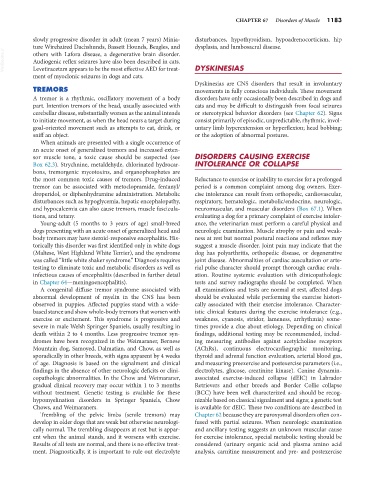Page 1211 - Small Animal Internal Medicine, 6th Edition
P. 1211
CHAPTER 67 Disorders of Muscle 1183
slowly progressive disorder in adult (mean 7 years) Minia- disturbances, hypothyroidism, hypoadrenocorticism, hip
ture Wirehaired Dachshunds, Bassett Hounds, Beagles, and dysplasia, and lumbosacral disease.
VetBooks.ir others with Lafora disease, a degenerative brain disorder. DYSKINESIAS
Audiogenic reflex seizures have also been described in cats.
Levetiracetam appears to be the most effective AED for treat-
ment of myoclonic seizures in dogs and cats.
Dyskinesias are CNS disorders that result in involuntary
TREMORS movements in fully conscious individuals. These movement
A tremor is a rhythmic, oscillatory movement of a body disorders have only occasionally been described in dogs and
part. Intention tremors of the head, usually associated with cats and may be difficult to distinguish from focal seizures
cerebellar disease, substantially worsen as the animal intends or stereotypical behavior disorders (see Chapter 62). Signs
to initiate movement, as when the head nears a target during consist primarily of episodic, unpredictable, rhythmic, invol-
goal-oriented movement such as attempts to eat, drink, or untary limb hyperextension or hyperflexion; head bobbing;
sniff an object. or the adoption of abnormal postures.
When animals are presented with a single occurrence of
an acute onset of generalized tremors and increased exten-
sor muscle tone, a toxic cause should be suspected (see DISORDERS CAUSING EXERCISE
Box 62.3). Strychnine, metaldehyde, chlorinated hydrocar- INTOLERANCE OR COLLAPSE
bons, tremorgenic mycotoxins, and organophosphates are
the most common toxic causes of tremors. Drug-induced Reluctance to exercise or inability to exercise for a prolonged
tremor can be associated with metoclopramide, fentanyl/ period is a common complaint among dog owners. Exer-
droperidol, or diphenhydramine administration. Metabolic cise intolerance can result from orthopedic, cardiovascular,
disturbances such as hypoglycemia, hepatic encephalopathy, respiratory, hematologic, metabolic/endocrine, neurologic,
and hypocalcemia can also cause tremors, muscle fascicula- neuromuscular, and muscular disorders (Box 67.1). When
tions, and tetany. evaluating a dog for a primary complaint of exercise intoler-
Young-adult (5 months to 3 years of age) small-breed ance, the veterinarian must perform a careful physical and
dogs presenting with an acute onset of generalized head and neurologic examination. Muscle atrophy or pain and weak-
body tremors may have steroid-responsive encephalitis. His- ness at rest but normal postural reactions and reflexes may
torically this disorder was first identified only in white dogs suggest a muscle disorder. Joint pain may indicate that the
(Maltese, West Highland White Terrier), and the syndrome dog has polyarthritis, orthopedic disease, or degenerative
was called “little white shaker syndrome.” Diagnosis requires joint disease. Abnormalities of cardiac auscultation or arte-
testing to eliminate toxic and metabolic disorders as well as rial pulse character should prompt thorough cardiac evalu-
infectious causes of encephalitis (described in further detail ation. Routine systemic evaluation with clinicopathologic
in Chapter 64—meningoencephalitis). tests and survey radiographs should be completed. When
A congenital diffuse tremor syndrome associated with all examinations and tests are normal at rest, affected dogs
abnormal development of myelin in the CNS has been should be evaluated while performing the exercise histori-
observed in puppies. Affected puppies stand with a wide- cally associated with their exercise intolerance. Character-
based stance and show whole-body tremors that worsen with istic clinical features during the exercise intolerance (e.g.,
exercise or excitement. This syndrome is progressive and weakness, cyanosis, stridor, lameness, arrhythmia) some-
severe in male Welsh Springer Spaniels, usually resulting in times provide a clue about etiology. Depending on clinical
death within 2 to 4 months. Less progressive tremor syn- findings, additional testing may be recommended, includ-
dromes have been recognized in the Weimaraner, Bernese ing measuring antibodies against acetylcholine receptors
Mountain dog, Samoyed, Dalmatian, and Chow, as well as (AChRs), continuous electrocardiographic monitoring,
sporadically in other breeds, with signs apparent by 4 weeks thyroid and adrenal function evaluation, arterial blood gas,
of age. Diagnosis is based on the signalment and clinical and measuring preexercise and postexercise parameters (i.e.,
findings in the absence of other neurologic deficits or clini- electrolytes, glucose, creatinine kinase). Canine dynamin-
copathologic abnormalities. In the Chow and Weimaraner, associated exercise-induced collapse (dEIC) in Labrador
gradual clinical recovery may occur within 1 to 3 months Retrievers and other breeds and Border Collie collapse
without treatment. Genetic testing is available for these (BCC) have been well characterized and should be recog-
hypomyelination disorders in Springer Spaniels, Chow nizable based on classical signalment and signs; a genetic test
Chows, and Weimaraners. is available for dEIC. These two conditions are described in
Trembling of the pelvic limbs (senile tremors) may Chapter 62 because they are paroxysmal disorders often con-
develop in older dogs that are weak but otherwise neurologi- fused with partial seizures. When neurologic examination
cally normal. The trembling disappears at rest but is appar- and ancillary testing suggests an unknown muscular cause
ent when the animal stands, and it worsens with exercise. for exercise intolerance, special metabolic testing should be
Results of all tests are normal, and there is no effective treat- considered (urinary organic acid and plasma amino acid
ment. Diagnostically, it is important to rule out electrolyte analysis, carnitine measurement and pre- and postexercise

